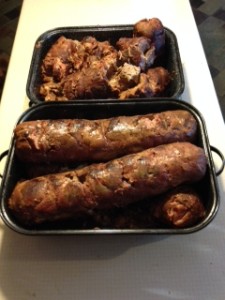
I once read that the use of fibrous casing in meat processing dates back to the American Civil War where coarse ground meat was stuffed in cotton bags for cooking. Today’s fibrous casing are still made out of cellulose, plus possess several good attributes for low temperature cookery:
-Strong walled
-Expand when product is stuffed into them and shrink with product during cooking
-Are semi-permeable to both water vapor and smoke
-It’s hard to over-smoke meat in fibrous casings and a smoke-ring still forms.
-Shields cooking product from fly-ash and may help filter out potentially harmful smoke solids
-Provides a consistent diameter to facilitate the uniform cooking of product
-Uniform casing dimension increases the pounds of meat that can be cooked at a time
-Holds enough product generated moisture around cooking meat to increase both heat transfer and the rate of collagen gelling (faster tenderization of tough meats).
-Large (red bologna chub size) fibrous casings hold up very well during long-low heat cooks
-Are big enough in diameter to stuff marinated meat chunks into by hand
-It’s easy to tie chub ends closed using butcher’s twine. Twine also holds up well during low heat cooks, I stay below the 250F range.
Turn the casings inside out, soak them for 30 minutes in warm vinegar water then turn them back right-side out for stuffing. That practice causes a protein skin to form against the casing wall during cooking. Protein skin greatly increases casing peelability and supplies some dark chewy meat to blend throughout the pulled/shredded end product. Sorry, there will not be any charred, dehydrated “bark” unless the end of a chub or two was placed against the metal cooker wall or the fuel/ flue pipe.
The removal of bone and heavy fat prior to marinating increases edible product volume, frees bones to make soup stock, frees fat for use in sausage production and makes the pulling/shredding of cooked meat a “breeze.” Further, heat transfer is more uniform when thick fat and bone have been removed: all is then similar material.
www.sausagemaker.com is an economical place to purchase large fibrous casings.
